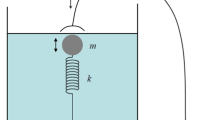Abstract
Behavior of dynamical process of complex systems is investigated. Specifically we analyse two types of ideal complex systems. For analysing the ideal complex systems, we define the response functions describing the internal states to an external force. The internal states are obtained as a relaxation process showing a “power law” distribution, such as scale free behaviors observed in actual measurements. By introducing a hybrid system, the logarithmic time, and double logarithmic time, we show how the “slow relaxation” (SR) process and “super slow relaxation” (SSR) process occur. Regarding the irregular variations of the internal states as an activation process, we calculate the response function to the external force. The behaviors are classified into “power”, “exponential”, and “stretched exponential” type. Finally we construct a fractional differential equation (FDE) describing the time evolution of these complex systems. In our theory, the exponent of the FDE or that of the power law distribution is expressed in terms of the parameters characterizing the structure of the system.
Similar content being viewed by others
References
S. Ide, A. Baltay, C. C. Beroza, Sciencexpress, 19 May 2011, science 1207020 (2011)
J. C. Bohorquez, S. Gourley, A. R. Dixon, M. Spagat, N. F. Johnson, Nature 462, 911
M. Kamaya M. Itakura, Eng. Fract. Mech. 75, 386 (2009)
H. Hara, S. Okayama, Phys. Rev. B37, 9504 (1988)
H. Hara, S. S. Lee, T. Obata, Y. Tamura, Proc. Inst. Stat. Math. 46, 477 (1998)
J. Koyama, The Complex Faulting Process of Earthquakes (Kluwer Academic Pub., Dordrecht, 1997)
J. Koyama, H. Hara, Phys. A46, 1844 (1992)
J. Koyama, H. Hara, Chaos Soliton. Fract. 3 (1993)
Y. Kawada, H. Nagahama, H. Hara, Tectonophysics 427, 255 (2006)
Y. Kawada, Ph.D. thesis, Tohoku University (Sendai, JPN, 2006)
H. Hara, Phys. Rev. 31, 4612 (1985)
H. Hara, Research of Physical Properties 57 (in Japanese), 58 (1991)
M. Koganezawa, H. Hara, Y. Hayakawa, I. Shimada, J. Theor. Biol. 260, 353 (2006)
C.-C. Lo, L. A. Nunes Amaral, S. Havlin, P. Ch. Ivanov, T. Penzel, J. -H. Peter, H. E. Stanley, Europhys. Lett. 57(5), 625 (2002)
H. Haken, Brain Dynamics An Introduction to Models and Simulations (Springer-Verlag, Berlin, 2008)
H. Hara, Physics in Neural Networks Model of Memory, In: A. Isihara and M. Wadati (Eds.) New Physical Properties (in Japanese, Kyoritu, Tokyo, 1990) 135
N. Takahashi, K. Kiatamura, N. Matsuno, M. Mayford, M. Kano, N. Matsuki, Y. Ikegaya, Science 335, 353 (2012)
N. Ikeda, Mod. Phys. Lett. B23, 2073 (2009)
N. Ikeda, Physica A 389, 3336 (2010)
W. J. West, M. Bologna, P. Girigolini, Physics of Fractal Operators (Springer-Verlag, New York, 2003)
M. D. Ortigueira, Physics of Fractal Operators (Springer Science+ Business Media R.V. Heidelberg 2011)
D. Baleanu, K. Diethelm, E. Scalas, FRACTIONAL CALCULUS Models and Numerical Methods (World Scientific, Singapore, 2012)
N. Nasuno, Ph.D. thesis, Iwaki Meisei University (in Japanese, Iwaki, JPN, 2009)
N. Nasuno, N. Shimizu, M. Fukunaga, Trans. Jpn. Soc. Mech. Eng. 76, 116 (2010) (in Japanese)
J. H. He, Therm. Sci. 15, S145 (2011)
J. H. He, Phys. Lett. A 376, 257 (2012)
C. M. Ionescu, R. D. Keyser, IEEE Transact. Biomed. Eng. 56(4), 978 (2009)
N. Heymans, I. Podlubny, Rheol. Acta 45, 765 (2006)
R. R. Nigmatullin, A. Le Méthauté, J. Non-Cryst. Solids 351, 2888 (2005)
R. R. Nigmatullin, Physica A 363, 282 (2006)
H. Hara, O. K. Chan, J. Koyama, Phys. Rev. B46, 838 (1992)
H. Hara, N. Ikeda, M. Furukawa, In: Proc. of 2nd. IFAC on Fractional differentiation and its applications, 304 (Port, Portugal, July 19–21, 2006)
H. Hara, Phys. Rev. B20, 4062 (1979)
H. Hara, T. Obata, Phys. Rev. B28, 4403 (1983)
H. Hara, T. Obata, S. J. Lee, Phys. Rev. B37, 476 (1986)
I. Suyari, Fundamental Mathematics for Complex Systems Power Law and Tsallis entropy (in Japanese, Makino Shoten, Tokyo, 2010)
C. Tsallis, Introduction to Non extensive Statistical Mechanics (Springer Science+Business Media. LLC, New York, 2009)
I. Podlubny, In: A. Le Méthauté et al.(Eds.), Fractional differentiation and its applications, 3 (2005)
Author information
Authors and Affiliations
Corresponding author
About this article
Cite this article
Hara, H., Tamura, Y. Dynamical process of complex systems and fractional differential equations. centr.eur.j.phys. 11, 1238–1245 (2013). https://doi.org/10.2478/s11534-013-0224-2
Received:
Accepted:
Published:
Issue Date:
DOI: https://doi.org/10.2478/s11534-013-0224-2




